Fitness Blog Covering Topics Of Interest
Thursday, November 26 2015
In his Autumn 2015 statement, the Chancellor pledges to spend £600m on mental health. Out comes the fan fare and heaps and loads of praise for him and his party on tackling the current unacceptable under funded mental health situation in England.
Let us, for a moment, step back and open the history books and look at mental health funding in England since 2010; the time when George Osborne, our Chancellor took office.
Funding for NHS trusts to provide mental health services has fallen by more than 8% in real terms since 2010, according to research by Community Care and BBC News. Figures obtained under the Freedom of Information Act from 43 mental health trusts in England show that total funding for the trusts’ mental health services dropped in real terms by 8.25 per cent, or almost £600m (once inflation has been accounted for). Now, after a reality check has been taken of the situation should we still be showering the Chancellor with praise for his generosity?.
In real terms, the Chancellor has been cutting funding to the most vulnerable persons in society, the mentally ill by £600m over the last 5 years and now we expect them to be thankful that he's giving it back. What sort of society do we live in where we make the most vulnerable suffer by not providing adequate services for them?. All that the Chancellor has done is to put mental health in England back to where it was in 2010 when he became chancellor and society should be grateful for this?.
Gym In Motion provides fitness programs to persons struggling with mental health illness. What we've seen over the past 5 years is the impact that the taking of £600m in cuts from the mental health services has had on the most vulnerable in society. Front line services being strained to their maximum, long waiting lines to access therapy while the majority of people with mental health issues just don't get any help at all. Society is denying these vulnerable people assistance in the name of saving money. Not only have I experienced this from a supplier's point of view, but from first hand experience as I have a number family members who suffer or have suffered with mental health illness over the years. No where, has any government minister, employee or consultant, looked behind the scenes and seen that by denying services to a person with a mental health illness, in most cases causes their mental state of mind to worsen and so they spiral into deteriation.
These are the consequences that are just brushed under the carpet, the consequences that aren't mentioned at dinner parties for they force society to take note of their actions which is not a pretty sight.
Somehow, I don't think that those with a mental health illness will be heralding our Chancellor for giving back to the mental health services, what was rightly there's in the first place. If I'm a cynical person, I'd say that this whole announcement was just for our Chancellor and government of the day to get brownie points and be seen to do something about a dire situation which they created in the first place. The uninformed will be thankful, the informed will not be amused.
References:
http://www.communitycare.co.uk/2015/03/20/mental-health-trust-funding-8-since-2010-despite-coalitions-drive-parity-esteem/
http://www.bbc.co.uk/news/health-31970871
https://www.mind.org.uk/news-campaigns/news/mental-health-services-cut-by-8-per-cent.aspx#.VlbJ5b-jKpA
http://www.cityam.com/229537/autumn-statement-2015-chancellor-george-osborne-promises-to-spend-an-extra-600m-on-mental-health
Monday, October 05 2015
The next time you have a check-up, don’t be surprised if your doctor hands you a prescription to walk. Yes, this simple activity that you’ve been doing since you were about a year old is now being touted as “the closest thing we have to a wonder drug,” in the words of Dr. Thomas Frieden, director of the Centers for Disease Control and Prevention.
Of course, you probably know that any physical activity, including walking, is a boon to your overall health. But walking in particular comes with a host of benefits. Here’s a list of five that may surprise you.
1. It counteracts the effects of weight-promoting genes. Harvard researchers looked at 32 obesity-promoting genes in over 12,000 people to determine how much these genes actually contribute to body weight. They then discovered that, among the study participants who walked briskly for about an hour a day, the effects of those genes were cut in half.
2. It helps tame a sweet tooth. A pair of studies from the University of Exeter found that a 15-minute walk can curb cravings for chocolate and even reduce the amount of chocolate you eat in stressful situations. And the latest research confirms that walking can reduce cravings and intake of a variety of sugary snacks.
3. It reduces the risk of developing breast cancer. Researchers already know that any kind of physical activity blunts the risk of breast cancer. But an American Cancer Society study that zeroed in on walking found that women who walked seven or more hours a week had a 14% lower risk of breast cancer than those who walked three hours or fewer per week. And walking provided this protection even for the women with breast cancer risk factors, such as being overweight or using supplemental hormones.
4. It eases joint pain. Several studies have found that walking reduces arthritis-related pain, and that walking five to six miles a week can even prevent arthritis from forming in the first place. Walking protects the joints — especially the knees and hips, which are most susceptible to osteoarthritis — by lubricating them and strengthening the muscles that support them.
5. It boosts immune function. Walking can help protect you during cold and flu season. A study of over 1,000 men and women found that those who walked at least 20 minutes a day, at least 5 days a week, had 43% fewer sick days than those who exercised once a week or less. And if they did get sick, it was for a shorter duration, and their symptoms were milder.
Thursday, July 16 2015
Mobility — the ability to move purposefully around your environment — is vitally important to health and well-being.
Nearly one-third to one-half of adults ages 65 and older experience impaired mobility. At first, it may not seem like a big deal — many people with impaired mobility learn to just move a little more slowly and a little more deliberately. Some people work around the problem by relying on a cane or walker.
That’s why it’s important to intervene to either prevent future mobility impairments or reduce existing ones.But taking impaired mobility “lying down” can cause your health to spiral downward. As you move less, pounds may start to creep on. You might withdraw from social relationships and activities that challenge you mentally. Exercise may become difficult, and lack of activity can worsen many health problems. This cycle of physical, emotional, and mental decline further restricts mobility.
For most people, the ability to rely on their own bodies, skills, and mental agility is a crucial part of living a satisfying life. Having full mobility helps you fully engage with the world and fosters a sense of self-sufficiency that can help you live independently well into your later years.
Friday, September 05 2014
Fruits and vegetables contain vitamins, minerals, and other nutrients that are essential for good health. That’s one reason why a plant-based diet that includes lots of fruits and vegetables can lower your risk of developing life-threatening diseases such as heart disease, diabetes, and some cancers. And when you pile on the produce, there’s less room for the unhealthy foods.
Dinner is typically the largest (and latest) meal of the day, and it’s a good opportunity to make sure that you meet your daily quota for fruits and vegetables. Here are five easy ways to work more produce into dinner.
- Roast vegetables. Roasting is a great way to let the deep, rich flavors of vegetables shine through. Bake cut vegetables at 375° F for 20 to 25 minutes or until they’re lightly browned. You can roast any vegetable — from mushrooms, onions, eggplant, and zucchini to tomatoes, broccoli, and carrots — so don’t limit yourself. Enjoy roasted veggies as a side dish or toss them into pasta dishes and other recipes.
- Poach veggies in low-sodium chicken broth and white wine. To poach, boil enough liquid to cover the vegetables. When it boils, add the vegetables. Turn down the heat to just below boiling and cook the vegetables for about five to seven minutes, until they’re brightly colored and tender-crisp. Add garlic, basil, or tarragon for a flavor bonus. To retain nutrients, keep a watchful eye on the pot, or set a timer so you don’t overcook.
- Smuggle fresh cut vegetables into main dishes. Try adding mushrooms, peppers, zucchini, onions, or carrots into pasta sauce, casseroles, soup, stews, scrambled eggs, and chili.
- Have a salad with dinner most days. Stock your salad with dark green leafy lettuce and toss in petite peas, tomatoes, onions, celery, carrots, and peppers. As an added benefit, starting meals with a salad can help you consume fewer calories at the meal, as long as the salad is no more than 100 calories. A healthful salad consists of about 3 cups of dark green lettuce, 1⁄2 cup carrots, a tomato, 1⁄4 cucumber, and 1 1⁄2 tablespoons of low-calorie dressing.
- Choose fruit — fresh or frozen, stewed or baked — for dessert. It all counts toward your daily produce quota. Dried fruits are healthy but high in calories, so eat them sparingly.
Monday, January 07 2013
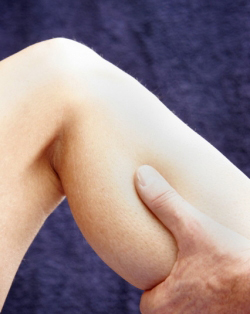
Sports massage is a form of massage therapy that is tailored to treat the needs of athletes. The use and application of specific techniques is the foundation of sports massage, yet what distinguishes it from other modalities is the intention behind the therapy. Many of us might think of massage as relaxing and holistic. Sports massage, in contrast, is designed to achieve specific goals, such as increasing performance or treating or preventing injury. The purpose of a sports massage session can vary, depending upon numerous factors that are unique to each athlete. For instance, sports massage can be used effectively to treat conditions such as tendonitis, strains, sprains, and adhesions. It can also be used in conjunction with training schedules and conditioning programs to enhance performance, aid in recovery and reduce the potential for injuries.
The major applications of sports massage are recovery, remedial (to improve a debilitating condition), maintenance, and event (pre, inter, and post). An athlete can enhance his or her performance by knowing when to incorporate sports massage into a training routine. Healthy, injury-free muscles perform better, longer, and with less chance of injury.
Sports massage can help to optimize the positive factors that affect performance, such as healthy muscle and connective tissues, normal range of motion, high energy and fluid and pain-free movement, as well as inducing mental calm and improving alertness, and concentration. It also can help minimize negative factors such as dysfunctional muscle and connective tissue, restricted range of motion, low energy, staleness, pain, and high anxiety(1a).
Sports massage decreases injury potential by helping to prevent acute injuries (muscle tears) as well as chronic injuries stemming from wear and tear (tendonitis). Regular massage allows the muscles and soft tissue to stay supple and healthy, lengthened and flexible and free from adhesions, thereby reducing the potential for injury. By increasing circulation and assisting the body’s healing processes and breaking down scar tissue and adhesions, sports massage can help chronic injuries get better.
Important Primary and Secondary Effects of Sports Massage(1b)
Primary effects refer to the physiological and psychological condition of the athlete and include:
- Improved fluid circulation (blood, lymph),
- Muscular relaxation,
- General relaxation,
- Functional separation of muscle and connective tissue (i.e., breaking up adhesions),
- Connective tissue normalization (releasing areas of tension, etc.),
- Increased mental alertness and clarity, and
- Deactivation of trigger points. (A trigger point is a nodule of tight muscle tissue that can refer pain locally or to other areas of the body.)
Secondary effects refer to performance-related outcomes and include:
- Greater energy,
- Greater flexibility and range of motion,
- More fluid movement (i.e., referring to the quality of the range of motion),
- Faster recovery, and
- Pain reduction.
If you decide that sports massage is the right treatment for you, it is important to find a well-trained therapist. Check out if a practitioner has had training in sports massage from an accredited school. Currently, there is no national credentialing that signifies a person who has passed a test demonstrating a solid understanding of the foundations and techniques of sports massage, so you will have to ask a few questions. How many hours of training (in general) did they have? Was their school accredited by the American Massage Therapy Association? How many hours of training in sports massage did they receive? What kind of athletes have they worked with? Were the athletes training or competing at the time? Is your therapist an athlete (on any level)?
Many sports massage practitioners participate in races or competitive events, which increases their understanding not only of the uses and benefits of sports massage, but of other factors that go into being an athlete. For example, the length of time between the massage session and the athletic event directly relates to the depth of pressure a therapist should use. A knowledgeable therapist will know that a pre-event massage, which is meant to encourage general looseness, calls for less deep work than a regular “maintenance” massage. It is important that your therapist always errs on the side of caution when using deep pressure, and that they have an understanding of the psychology of an athlete and the physical demands of training.
One of the benefits of working regularly with the same sports massage therapist is that he or she can learn to feel what is “normal” for your tissue and body type and can keep a watchful eye on any changes that may signal the need to head off potential trouble spots. If an injury does occur, the therapist can join the team of health care practitioners helping you to recover. Here, the focus is on healing the injury quickly and effectively, minimizing the side effects of the injury and decreasing the chance of re-occurrence.
The use of sports massage in training routines varies depending on the athlete, the sport being trained for and the level of competition. It is important to mention that every athlete and every situation is going to be different, and that each person should research and find a plan that is most suitable for them. With that in mind, let’s take a look at how two different athletes used sports massage in conjunction with their training.
When Uta was competing in 5K to 10K races, or preparing for a marathon, she received sports massage twice a week. Usually, she scheduled her massages the day after one of her harder training sessions for the week. If that wasn’t possible, she would allow herself a treatment session on the same day as her hard workout, but she would wait at least 3 to 4 hours to let her body recover some from the training before addressing soft tissue needs. Getting regular massage during her intense training periods also helped Uta psychologically, by allowing her to give back to her body and take some time for herself.
Training for my first triathlon, I used sports massage regularly. I noticed that I could identify potential problems and head them off before they became an impediment in my training. I also felt, during the most intense training periods, that taking the time to give back to my body really helped me to feel like I was rounding out my training program. Having time to recover, making the effort to work my muscles and being in tune with my body, all played integral roles in my ability to train as hard as I did, without hurting myself.
Getting regular massages during training is a great way to generate feedback for yourself about how you are doing. The more feedback you can gather about performance and training, and how your body is responding to it all, the better informed you will be about how you can compete and recover from competition. Sports massage, therefore, can be a great tool for athletes in their training. It provides myriad benefits, including increasing performance potential, speeding recovery time, and reducing the prevalence of injuries. And let’s not forget the wonderful relaxation, stress relief, and whole body integration that everyone—not just the athlete—can obtain from massage!
Sunday, October 14 2012

Trampoline Boy © Betty Shepherd
Our children are our future—and understanding and supporting their natural yearning for physical activity will help lead them to a lifetime of happy and healthy living. If we joyfully teach them how to include healthy exercise from the early stages of their development, we will be giving our children a gift that will endure throughout their lives.
Among the many benefits are physical fitness, confidence and stronger self-esteem, more energy, better memory, and simply a good feeling about themselves—and they are easy to achieve. Our Take The Magic Step® team is as concerned as many of you about the growing problem of childhood obesity and the lack of exercise in their lives. Whether this obesity and inactivity is caused by the popularity of video games or the declining hours of physical education in schools, it is a wake-up call for everyone. Happily, there are ways of reversing this growing trend and helping our children to enjoy daily exercise and outdoor activities, which they love given the opportunity.
Our “Children’s Fitness and Health Program” is geared towards parents and educators, and focuses on creative ways to incorporate exercise into our children’s everyday routine. Outdoor games and playful workout routines can be the tools that instill lasting joy of exercise. I was so lucky that I was introduced to, enjoyed and benefitted from these activities during my childhood. It created in me an appreciation and understanding of the complex benefits that fitness and exercise can add to a person’s wellbeing. Over the years I’ve been fortunate to share this lasting experience with many children and young adults. (I hope you find additional information in the “Families” section of this Web site).
To emphasize once again the importance of exercise, I have put together some of the health benefits an active child can expect.
Exercise Improves Physical Health
Long-term health benefits of exercise are:
- A stronger immune system! The body’s ability to fight disease is improved. Children are less prone to colds, allergies, and diseases, including cancer.
- A reduction of type 2 diabetes by increasing insulin sensitivity and improving carbohydrate metabolism.
- A lower blood pressure and an improvement of the child’s cholesterol profile.
- A strengthening of the entire cardiovascular system, including the heart and lungs. The heart develops a higher “pump-activity” while the child’s heart and lungs are strengthened, supporting the prevention of heart disease.
- Children are less likely to become overweight and will have better control of their body fat. Overweight children are able to reduce their body weight and body fat due to the physiological effect of burning fat while exercising.
- Children develop stronger bone structure and muscle structure.
Active children enjoy additional health benefits, because:
- Exercise increases the blood flow to all body tissues, including the brain. Greater blood flow transports more oxygen and nutrients to the body’s cells.
- Active children improve their body’s ability to absorb oxygen through aerobic exercise. Due to the increased oxygen in their body’s cells they feel more energized. More oxygen translates into more energy!
- Increased blood flow promotes the body’s transportation of the byproducts of metabolism and toxins back from the cells for elimination, recycling, or further use elsewhere. Children who exercise feel fitter and more energized because of their body’s ability to detoxify.
- Active children breathe better and sweat more. Breathing and sweating are great ways to detoxify the body and help it keep itself “clean.”
- Children increase their over-all fitness through exercise(1).
Exercise Improves Mental Health
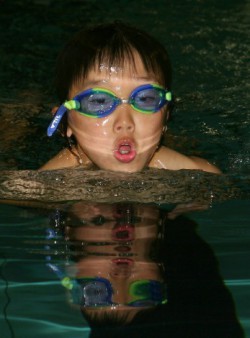 © Betty Shepherd
© Betty Shepherd
- Exercise enhances the brain’s metabolism. Studies show that active children have improved memory as a result of better brain function!
- Moderate, fun-oriented exercise literally burns off excess harmful hormones and, at the same time, increases the release of beneficial ones. One of the beneficial hormones acts as neurotransmitter for establishing new memories.
- Active children have the ability to concentrate much better, even at the end of a long school day.
- Studies report that exercise decreases anxiety, reduces depression, and improves mood and outlook in children. In addition, their quality of sleep is improved.
Perhaps most importantly, physical activity develops children’s self-esteem and confidence. Their ability to overcome difficult situations improves and they simply enjoy a better, sunnier outlook on life.
To parents and educators: Your efforts to encourage our children to exercise more and instill in them the wisdom of good nutrition and a healthy lifestyle will yield years of dividends in these young people’s lives. (… and the benefits mentioned are for adults too.)
To YOU CHILDREN: I wish you enjoyment of all your outdoor activities, your exercise, and your school! We are always with you!

Reference:
(1) Gavin ML (Medical Editor, KidsHealth.org), Dowshen SA (Chief Medical Editor, KidsHealth.org), and Izenberg N (Editor-in-Chief and Founder, KidsHealth.org): Fit KIDS. 1st edition, DK Publishing, Inc., New York, NY 2004.
Updated April 1, 2011
Copyright © 2006-2012 Uta Pippig
Saturday, July 28 2012
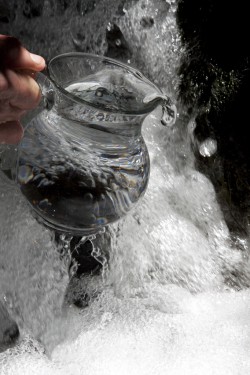
When you decide on your favorite summer workouts—we discussed a few fun options in Part I—you can move on to organize everything so you stay healthy and well-hydrated during your fitness routine.
First of all, add extra care to how you prepare for your workouts. Make sure you are properly hydrated beforehand. Drink small amounts of water frequently, beginning two hours before you go out. I would not necessarily drink too much for 20 to 30 minutes prior to your start, though, because it can make you need to “go” while working out.
If you plan to work out for more than one hour, you might want to run with a water bottle belt, as many athletes do. You also could leave one or more water bottles on the course. If you decide on that strategy, it is best to stay on a loop course. This gives you a chance to replenish every few miles. And, if you want to be absolutely safe, ask a friend to join you on a bike. For bikers, use both your water bottles, and stay ahead of the game by stopping at any convenience store or gasoline station to fill-up your bottles before you need them again.
Listen to Your Body, Stay Healthy
Nothing is more important than listening to your body. If you do not feel well, please be very cautious. Before, during, and after your workouts, the first signs of a possible problem might be heavier breathing, an elevated heart rate, or losing concentration. Consider wearing a heart rate monitor—it can caution you before you run into trouble.
When you feel unwell, admit it to yourself early on and get out of the heat right away. Cool off with a cold towel, use ice cubes, and hydrate! Please, do not wait to see a physician if you do not feel better immediately. Be familiar with some of the early warning signs of overheating: dizziness, fainting, fatigue, hot skin and followed by chills, lack of perspiration, feeling thirsty, and elevated heart rate. If you stop sweating, you most likely are very dehydrated(1).
Also be careful after your workout. Take a dry shirt to put on after your run, and always take some fluid to drink. If you feel cold—even in summer, for example when you come from outside into an air-conditioned room while still wearing your wet workout clothes—change immediately into dry clothes. It may be summer, but you need to stay “warm” after your workouts to avoid weakening your immune system and maybe getting a cold.
For adequate protection, sunscreen, glasses, a summer hat, and a rain jacket are always good to have close by.
Hydrate Well Throughout the Day
 © Betty Shepherd
© Betty Shepherd
It can be very warm and dry during the summer, so make sure you stay cool and hydrated at all times. There are some guidelines I would suggest, and one of my favorite is to keep a bottle of water or a sports drink close by. This will remind you to drink and get replenished with small amounts continuously and evenly spread out throughout the day.
Hydration is critical for many body functions, such as digestion, regulation of body temperature, and the circulatory processes that bring nutrients to the cells and transport waste from them. This is even more understandable when considering that our bodies are up to 75% water in total, depending on age and build, with blood being 83% water and the brain being 75 to 78% water. These are the levels when each of those organs work best(2).
When you get dehydrated, every cell in your body suffers, causing you to feel less fit and fatigued(3). This puts more stress on your body and makes you more prone to illness and disease. And you can be at risk of overheating, which can have terribly serious consequences—including being life-threatening.
For proper hydration, start with juice from a fresh squeezed lemon with lots of water first thing in the morning. It is good for re-hydration after your night’s sleep and also will help your body to detoxify.
And as mentioned earlier, drink enough before, if possible during, and right after your training. It is best to replenish within 30 minutes of finishing your workout—the so-called “recovery window.” I like to eat a big slice of water melon right after my training, it is a great source of water, antioxidants, and easily digested carbohydrates. In the following article “General Guidelines,” you can find more information on this topic.
A Few Thoughts on Summer Nutrition
 © Betty Shepherd
© Betty Shepherd
Many people like to adjust their nutrition and take advantage of everything that is fresh and more available in the summer, like tasty fruits and vegetables. It is berry season—maybe you are lucky enough to be able to pick your own on a berry farm. Eat food that has high water content like melon, citrus fruits, berries, and vegetables.
Diluted fruit juices with 1 part juice and up to 2 parts water can help you to stay hydrated. The juice from sour cherries, for example, has many health benefits and can even support faster strength recovery for runners.
You also can try the many different kinds of unsweetened iced teas. My favorite flavor is mango.
Enjoy what you eat and make it tasty. Add some cool summer nutrition like different kinds of smoothies. Depending on the amount you make, they even can be served as an entire meal. Just add water, berries (like raspberries and blueberries), banana, whey protein, and some ice cubes into a blender. Mix it and enjoy. Or try a variation with mango or pineapple. And for more health benefits, add a teaspoon of ground flaxseeds.
There also are many delicious salad creations with great dressings. You could try a variety of citrus dressings. Other choices of salads include my favorites—fresh cucumber salad with dill and onions or a tomato salad with olives, feta, and basil.
Sashimi and sushi can be delightful lighter dinner fare when well-portioned. And when you prepare your meals, add more vegetables than pasta or potatoes. And how about cold summer soups like water cress and gazpacho?
And for all you BBQ lovers, here are some thoughts on “Healthier Grilling.” I hope you can enjoy many relaxing summer evenings with your family and friends.
Good luck for your summertime fitness!

Sunday, June 10 2012
 © Betty Shepherd
© Betty Shepherd
Summer is such a beautiful time of the year. Happy days with stunning sunrises, long, warm evenings and relaxing afternoons freshened up with lemonade and watermelon. Even on hot days, it is not difficult to find great exercises to keep your fitness level up.
Summer is also special because you can finally do the workouts you might have been missing during the colder months of the year. You even can take advantage of the training sessions you would not necessarily do during the ideal training period for other sports in winter.
You can add cross-training, as well. That means you can work out in other sports or add exercises that support what you normally focus on. It gives you an opportunity to prepare yourself for your upcoming autumn events or improve your fitness and skills for your favorite winter sports. Cross-training can give you a wide variety of workout choices which can enable you to reach your goals.
In the summer, you have a wonderful opportunity to take advantage of the outdoors and experience beautiful connections to nature—the oceans, lakes, rivers, beaches, mountains, and shady woods and forests.
Before we go on, however, I would advise getting a physical before you start your summertime fitness, making sure you are fit enough to work out in those warm conditions and are able to stay ahead of the game. It is a time that is good for more than just goal setting. You also can talk about your fitness ideas and workout possibilities for the upcoming months and decide if they are realistic for you.
Your Favorite Summer Workouts
Of course, in summer—as well as year-round—do activities you enjoy. They might include your favorite ball game, long hikes, water sports, or anything that is giving you excitement and happiness while exercising.
Maybe you have some “wishes” you can turn into goals—like improving your fitness, learning to surf, running your first 5K, hiking a mountain, or biking some new trails by the end of the warmest time of the year. When you follow a path of realistic and achievable short-term goals, it can be much easier to stay motivated and make it fun to reach your goal.
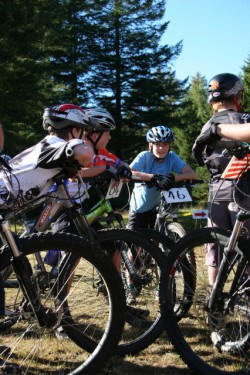 © Betty Shepherd
© Betty Shepherd
It always is a good idea to include your favorite workouts first, then, integrate new opportunities as the summer progresses. By the end of the warmest months, you will have explored and tried different exercises—alternatives you may have been curious about, perhaps, and had thought could be fun for you. Ball games, swimming, water sports, mountain biking, running, hiking, camping, for example, all are great exercises to try during the summer, especially if you had never done so before or if it had been a long time since you did them. And if you are ready to take on multiple challenges, nothing might be better than combining a number of activities.
My favorite summer workouts are those easy and relaxing evening runs, when the sun starts to set and the air is getting fresher, when I can play with those long shadows in the forest. I often combine them with a swim, diving into a lake after my run. Sometimes I jog a few miles to a beach by a lake and cool-off by swimming for some distance, depending on how I feel after my run. I used to do this often as a kid and later during my track season. I have enjoyed it ever since.
As the previous comment illustrates, summer workouts are a great way of rekindling happy childhood memories: those long days of carefree summer vacations from school, playing baseball, basketball, or soccer, or maybe completing a track session in the stadium. Perhaps you have a loving memory of the smell of freshly cut grass. That wonderfully distinctive aroma always reminds me of the newly-mown infield at the local track when I was a kid.
During the warmest time of the year, it is best to wait for temperatures to have fallen in the early morning or the late evening. Any kind of ball game—basketball, baseball, soccer, or tennis—is fun to play in the cooler evenings. With dusk still far away, you can arrange to get together with your friends after work and add informal versions of these games to your other activities. This can be fun and often makes it easier to stay fit.
When I was growing up and started running, we played lots of ball games as warm-ups for our training sessions. A game of team handball or volleyball was just right for us kids. Coming from Germany, soccer always was the favorite. Maybe you can join a group of friends to play a game? You will soon find the countless sprints to get the ball or trying to keep it will definitely give you good cardiovascular exercise. Huffing and puffing, I sometimes had to stop running to catch my breath.
For many of us, nothing is nicer than taking part in summer water sports. You can enjoy the whole day at a lake or the ocean with activities such as paddle boarding, kayaking, surfing, snorkeling, or playing different water ball games with your friends. These all are sports that can provide fun activities for you and your entire family.
If you don’t have the luxury of a few free days, try a nice swim before or after work, or, if time permits, during your lunch break. Swimming is not only a great cardiovascular workout, and refreshing during the summer months, it also can help you recover from more strenuous training like biking or running. And, at the same time, it will improve deeper breathing.
 Dave enjoys kayaking across the state of Florida. © Dave Bracknell
Dave enjoys kayaking across the state of Florida. © Dave Bracknell
A former client of mine started with a few sprint triathlons in the summer and quickly moved up to the Olympic distance in winter. He later discovered that kayaking would be fun for him, too. I got an email message from him with breathtaking photos of the ocean and his kayak resting on a beach. He wrote that he just kayaked across the state of Florida in a charity event.
I can imagine that he had a fun pool party afterwards! It is a great idea to start a party with your family and friends in late afternoon, playing ball and enjoying swim games, and later taking in the sunset while having a super-tasty barbecue.
Could an interesting hike become one of your favorite workouts? Even a leisurely “glow worm and fire flies” hike on a cool summer night might be something you would enjoy. It can be such a fun activity for the whole family. And if you choose a long day hike, you might want to top it off by camping out overnight under the stars.
Change the Venue, Adjust Your Goals, and Explore Cross-Training
Sure, you want to avoid the hottest part of the day—so go inside! Join a gym for the warmest months, and instead of running or biking outside, try the treadmill or the stationary bike or one of the many other aerobic exercise machines available at most gyms. You always can exercise outside during the cooler temperatures around sunrise and sunset.
The nice thing about summer events is that most of them take place in the morning or evening hours. Nothing is better than completing your workout or event and meeting friends for a late breakfast afterwards. “It’s just a piece of pancake!”
Adjust your fitness goals for the warmest time of the year. As always, it is best to set realistic, achievable, short-term goals. I recommend focusing on a few shorter workouts with higher intensity and playful variations in speed. Perhaps your goal might be to become faster in your sport during the summer. Then in autumn, you can add some endurance and focus on longer events again.
Once you accomplish your summer goals, you can use your improved fitness to achieve great results in your events later in the year.
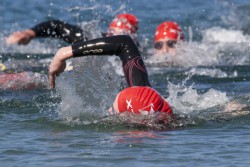 © Betty Shepherd
© Betty Shepherd
Here are some ideas. If you are a triathlete, you might want to improve one of your disciplines to be better prepared for competition in the fall. To work on your swimming might be a good idea. Or you might change from running to more biking, and in the colder months add longer running workouts again. There are great duathlon competitions in the summer. To work on improving your speed, you may decide to prepare for a sprint triathlon or a sprint duathlon, instead of the longer versions.
Many runners may just have finished a spring marathon. The warm summer months are ideal to prepare for a 5K, and in late August one could prepare for a 10K. Then, in September, you can get ready for a half marathon. All the training and goal setting can be done with the ultimate aim of a faster marathon. Or simply enjoy the shorter distances as your main event all summer. That is good, too!
You also can switch from one sport to another. Think “off season training.” For runners, bike and swim instead of doing high mileage running. Some bikers go from the road into the forest and mountain bike, it is a great way to improve your skills. Enjoy water sports like kayaking or paddle boarding. Compete in team swimming events, relays are always great fun.
A good goal could be to work on other elements of fitness, like strength or technique training, especially if these are areas in which you already want to improve. To do this, you may want to include these new elements in your routine during the summer so you are better prepared for your upcoming events later in the year.
I love these elements of cross-training. They can give you a chance to try out a variety of workouts—not doing the same activity every day. And they can be done indoors during the warmest hours of the day. Think about it as something you can look forward to complement your training. Deep-water running, core strengthening, light weights, stretching and yoga… they all can be added to your summertime fitness routine. In this manner, you can condition your body for your fall events—to be a better runner, biker, or golfer—and for your winter sports to be a stronger skier, snowboarder, or skater.
Be prepared to adjust your workouts according to the weather conditions on any given day. It can be hot, humid or rainy, and setting a new and easier goal will help you achieve them. Maybe you, too, would love to combine some of your runs with a cooling swim afterwards.
And finally, a general suggestion for your summer workouts: start them slowly, increasing your workload in gentle increments. The weather conditions can be challenging and even deceptive. By starting your workouts carefully, keeping your strength in reserve, you will be able to keep your body temperature and your pulse lower. And you will not get so fatigued.
In many climates, temperatures can change dramatically over the course of the day, so always be aware of the conditions in which you do your activities and training. Of course, during summer months, adequate hydration should always be on your mind.
Fitness Programs and Sport Events You Can Join
Check out recreational leagues and programs for adults and kids in your area. Your town, local fitness club, and local businesses might offer programs for many sports and events, and maybe you would like to join one of them. This way you also might meet new friends and enjoy staying fit together. It might even not feel like working out hard at all.
There are many events over the summer that may be of interest to you. Some of them are charity rides or runs where you also can get the satisfaction of helping your community or a charity that touches your heart like SOS Outreach with which Take The Magic Step is a partner.
In “Summertime Fitness: Part II,” I will explore proper hydration and offer a few thoughts on summer nutrition.
Until then, I hope you can enjoy your fun and cool summertime fitness!

Please Spread Our News With Others
|

















